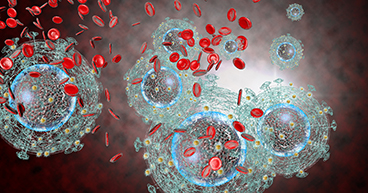
New studies are finding a surprising potential ally in the fight against cancer: certain deadly viruses. In fact, since the late 1800s, doctors have observed that some cancer patients with viral infections have gone into remission, even though the reprieve was mostly temporary. The relationship may seem counterintuitive, but today researchers believe the cause and effect may be more than happenstance. They are studying several dozen viruses to learn how they may be used to shrink or destroy tumor cells, while also triggering the immune system to attack the cancer—both at the site of the virus injection and elsewhere in the body.
“Oncolytic virus therapy, as it's often referred to in the medical community, is now recognized as a kind of immunotherapy, and the excitement around this form of treatment stems largely from its perceived ability to turn on the immune system to fight the cancer.” says Alan Tan, MD, Clinical Research Medical Director & Medical Oncologist and Hematologist at our hospital near Phoenix.
What happens when viruses are injected into tumor cells?
When certain viruses, such as human papillomavirus (HPV), chickenpox or smallpox, are genetically modified and injected into a tumor cell, they make copies of themselves, eventually causing the cell to burst. Not only does that reaction kill the cancer cell itself, the dying cell also releases substances, such as tumor antigens, that allow the immune system to recognize that type of cell as foreign, prompting an attack. “These tumors are sort of hiding from the immune system,” Dr. Tan says. “But certain genetically modified viruses may cause the release of tumor-associated antigens and a chemical messenger that, together, trigger an immune response.”
Although the initial findings are promising, using viruses to fight cancer is still very much in its infancy. “By itself, this type of therapy has not been shown to increase overall survival rates,” Dr. Tan says. “Also, in a clinical trial, the majority of patients didn’t seem to benefit.” But researchers believe patient responses may be improved by combining virus injections with checkpoint inhibitor drugs, such as nivolumab (Opdivo®), ipilimumab (Yervoy®) and pembrolizumab (Keytruda®).
The future of viruses
Dr. Tan, who has used the therapy to treat patients, is optimistic about its future. “We’ve already seen benefits to patients when combining a virus injection with ipilimumab, for instance, and some studies suggest that this treatment, combined with other therapies, may lead to increased survival rates in patients,” he says. In fact, a National Cancer Institute-sponsored clinical trial is now studying whether patients with advanced melanoma tumors that haven’t responded to immunotherapy will benefit from the therapy. Researchers believe that injecting these patients with a specific genetically modified virus before delivering a checkpoint inhibitor drug may enhance the drug’s effect, by improving the immune system’s ability to recognize the cancer cells.
Right now, talimogene laherparepvec (Imlygic®), also called T-VEC, is the only oncolytic virus therapy approved by the U.S. Food and Drug Administration, and it’s only approved to treat certain patients with metastatic melanoma that cannot be surgically removed. But research is underway to test how other oncolytic viruses may be used to treat patients with brain tumors and sarcomas, as well as breast, lung, liver and bladder cancers. “We are in the era of precision medicine and immuno-oncology,” Dr. Tan says. “We are getting away from the mentality of a one-size-fits-all treatment strategy. There is unlikely to be a ‘magic bullet’ that cures all cancer because there are just too many differences between types, and even within the same kind of cancer. I think modern-day medicine is on the right track, though, and combining therapies is a major piece of that.”



